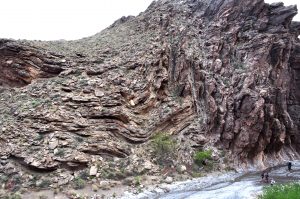Earlier last month I returned from a research rafting trip in Grand Canyon where I assisted Dr. Andrew Snelling, Director of Research for Answers in Genesis, in collecting rock samples from several areas in the Grand Canyon where the rocks exhibit large bends or folds. The permit to collect the samples in the National Park was only granted after ADF (Alliance Defending Freedom) filed a federal lawsuit on behalf of Dr. Snelling, asserting that the National Park Service improperly engaged in viewpoint discrimination based upon Dr. Snelling’s worldview. You may have seen some of the national stories about the lawsuit this past spring.
Creationists have contended the only way for the folds to form is the sediments were bent when they were still soft, a relatively short time after the sediments were deposited. Only after folding did the sediments become hard rock. On the other hand, those who hold that the earth is old, believe the folds were formed under extreme amounts of heat and pressure hundreds of millions of years after the sediments had already become hard. The problem, creationists contend, is that hard rocks break – they do not bend. To date, we can find no evidence anyone has studied rock samples from these folds to confirm which hypothesis is true, understandably as the rocks are in hard-to-access areas deep within the canyon.
This collection of rock samples is just the beginning of an ongoing research project. Over the next several months, the samples will be studied under the microscope and with X-ray diffraction techniques to determine the timing of the folding. If these studies confirm the rocks were bent while still soft very soon after their deposition, it will become a powerful argument for the timing and method of deposition for at least the layers found in the Grand Canyon. Stay tuned!
You can see Ken Ham’s blog post here.

Posted in: Uncategorized
















